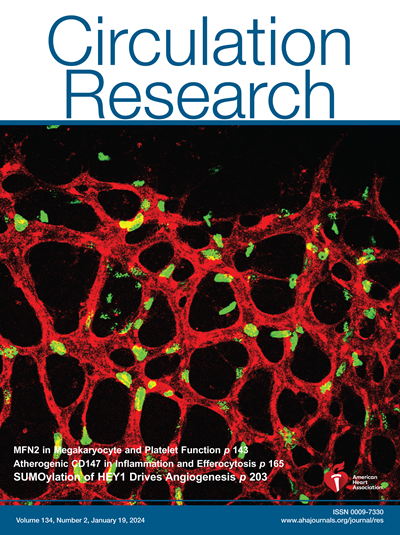Novel Truncated Peptide Derived From circCDYL Exacerbates Cardiac Hypertrophy.
IF 16.5
1区 医学
Q1 CARDIAC & CARDIOVASCULAR SYSTEMS
引用次数: 0
Abstract
BACKGROUND Circular RNAs (circRNAs) have been gradually revealed to regulate the progression of heart disease in depth, showing their clinical significance. However, a mass of cardiac circRNAs still has not been functionally characterized. We aimed to explore the potential candidates that are involved in pathological cardiac hypertrophy. METHODS Public substantial RNA-sequencing data of cardiac circRNAs were utilized to search the cardiac hypertrophy-related circRNAs. Cardiomyocyte hypertrophy in vitro was induced by Ang II (angiotensin II) treatment. Mice were subjected to Ang II infusion to induce cardiac hypertrophy in vivo. Gain-of-function and loss-of-function assays were conducted to detect the effect of RNAs or proteins in cardiac hypertrophy. RESULTS A circRNA derived from the cdyl (chromodomain Y-like) gene was screened out and named circCDYL. Our results showed that the expression of circCDYL in primary rat cardiomyocytes was significantly induced by Ang II. Gain-of-function and loss-of-function assays demonstrated that circCDYL effectively promoted cardiomyocyte hypertrophy in vitro. CircCDYL could encode a ≈100-aa truncated CDYL peptide (tCDYL-100), whose sequence highly overlaps that of full-length CDYL. The translation of tCDYL-100 was activated by N6-methylation of circCDYL under prohypertrophic stimulation. tCDYL-100 fulfilled the prohypertrophic of circCDYL. Mechanistically, tCDYL-100 competed with CDYL for binding REST (RE1-silencing transcription factor) and further disrupted the formation of REST-CDYL-EHMT2 (euchromatic histone-lysine N-methyltransferase 2) transcriptional repression complex, resulting in transcriptional activation of rhoa and nppb. Silence of circCDYL in mouse hearts could inhibit Ang II-induced cardiac hypertrophy, while forced expression of tCDYL-100 could cause cardiac hypertrophy. CONCLUSIONS In summary, our study uncovered an important circRNA-derived peptide and a regulatory mechanism on transcription mediated by N6-methyladenosine-circRNA-histone methylation in pathological cardiac hypertrophy.求助全文
约1分钟内获得全文
求助全文
来源期刊

Circulation research
医学-外周血管病
CiteScore
29.60
自引率
2.00%
发文量
535
审稿时长
3-6 weeks
期刊介绍:
Circulation Research is a peer-reviewed journal that serves as a forum for the highest quality research in basic cardiovascular biology. The journal publishes studies that utilize state-of-the-art approaches to investigate mechanisms of human disease, as well as translational and clinical research that provide fundamental insights into the basis of disease and the mechanism of therapies.
Circulation Research has a broad audience that includes clinical and academic cardiologists, basic cardiovascular scientists, physiologists, cellular and molecular biologists, and cardiovascular pharmacologists. The journal aims to advance the understanding of cardiovascular biology and disease by disseminating cutting-edge research to these diverse communities.
In terms of indexing, Circulation Research is included in several prominent scientific databases, including BIOSIS, CAB Abstracts, Chemical Abstracts, Current Contents, EMBASE, and MEDLINE. This ensures that the journal's articles are easily discoverable and accessible to researchers in the field.
Overall, Circulation Research is a reputable publication that attracts high-quality research and provides a platform for the dissemination of important findings in basic cardiovascular biology and its translational and clinical applications.
 求助内容:
求助内容: 应助结果提醒方式:
应助结果提醒方式:


